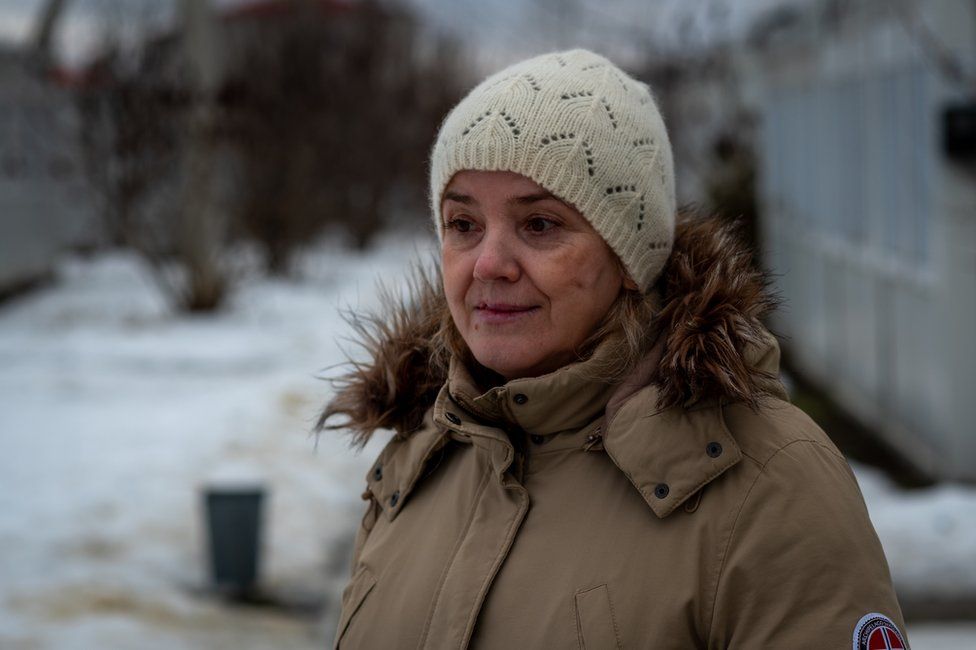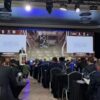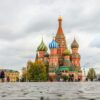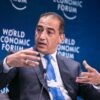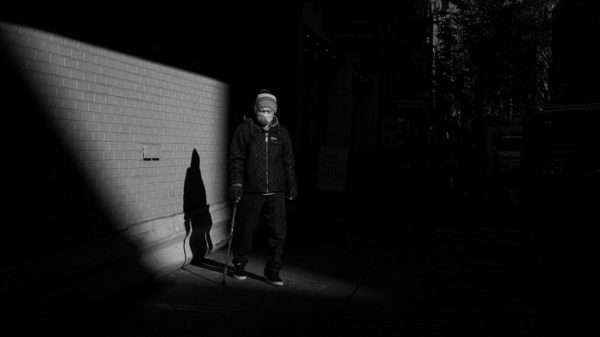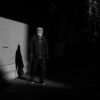About half an hour’s drive from the centre of Kharkiv in eastern Ukraine, in a low-rise industrial area of the city, there are rows of what look like white shipping containers set back from the main road and ringed by a blue metal fence.
The rows of containers, blanketed by snow this time of year, are actually a village of temporary housing units for people who already fled the war in Ukraine once, back in 2014 when Russian-backed separatists seized much of the Donbas region by force.
The residents of the “module city” live in remarkably cramped conditions – imagine a portable cabin you would see on a construction site, with low ceilings and strip lights, divided into a living room, kitchen and bathroom area and occupied by families of two or three or more.
“Yes, the accommodation is depressing,” said Liudmyla Bobova, a resident who shares a private unit with her husband and elderly mother – a relative luxury compared with their previous unit where they occupied one small room in a communal unit, sleeping on bunk beds and sharing a kitchen and toilet.
And yet Bobova and her family are grateful to be here, she said. “There is occupation,” she said, referring to the separatist territory they fled. “Life there is grey, you cannot breathe freely. Here, I can breathe freely.”
As for her change in living conditions, she only shrugged. “That was one life, this is a another life,” she said.
In her previous life, Bobova lived in Molodohvardiisk, a small mining town a stone’s throw from the Russian border, where there was little political activity and people were only absent-mindedly pro-Russian, she said.
Her family fled the region along with thousands of others when the war began, escaping by foot and train as shells fell “like rumbling thunder”, she said.

They ended up in the module city and have lived here since. The modules – paid for by the German government – had a maximum shelf life of three and half years for human occupation, but seven years on about 175 people remain.
“There’s nothing more constant than the temporary,” said Artur Statsenko, who oversees the units for the local council. “The state hasn’t managed these people at all. For the past eight years we have not received anything from the state budget. We have a special Ministry for Reintegration but they have not given us a penny.”
The BBC asked the Ministry for Reintegration – created in 2014 and tasked with caring for internally displaced persons (IDPs) from Donbas – to respond, but they declined to answer questions.
For the IDPs, Russia’s looming new threat to invade Ukraine brings the prospect of a double displacement. Their temporary homes, just 25 miles from the border, would be squarely in Russia’s path. But an invasion appeared to be low down the list of concerns for the module city residents.
“We don’t talk about the escalation, or the fact we might have to flee again,” said Iryna Belinska, a 64-year-old grandmother of nine who lives in a unit with her unwell husband.
“We need a proper roof over our head, not a plastic little house,” she said, gesturing to her broken ceiling and bowed floor.
“We have much more mundane things on our minds than war.”

The “escalation”, as people here tend to call it, has shifted the cultural identity of Kharkiv, a historically Russian-speaking city 300 miles from Kyiv but just 30 miles from the Russian border. Belinska spoke in Russian, but Bobova only speaks Ukrainian now – she abandoned Russian overnight in 2014 when she arrived in Kharkiv.
The separatists who seized Donbas attempted to seize Kharkiv too, and briefly they raised their flag on the regional government building in the city centre. The ousted Ukraianian president Viktor Yanukovych fled here in search of political support, but he was met by street protests and fled again to Crimea, and Kharkiv, Ukraine’s second most-populous city, remained undisputed.
“Kharkiv was always pro-Ukrainian,” said Boris Redin, an avuncular lifelong “Kharkiver” who has operated a kind of pro-Ukraine protest tent opposite the local government building since 2014. “But it has become more pro-Ukrainian since the war started, like every city,” he said. “If the Russians want to attack us, they are our guests, we are not afraid.”
Kharkiv would be a logical destination for the Russians if they rolled over the border nearby, but Vladimir Putin’s troops could face a grinding resistance from the population. Many have enrolled in volunteer battalions and trained to fight, and two weeks ago the city’s streets filled with protesters again, this time chanting “Kharkiv is Ukraine” and “stop Russian aggression”.
“People have joined the territorial defence, volunteers continue to go the warzone, all this is working,” said Svitlana Gorbunova-Ruban, the deputy mayor of Kharkiv. “We are ready to defend our city in any situation and by all means.”

There is a lot here to defend – 38 universities, museums, a thriving tech sector and vibrant contemporary arts scene. The celebrated Ukrainian writer Oksana Zabuzhko just finished a three-week residency here.
“There was an explosion of art in Kharkiv when the war began,” said Natalia Ivanova, director of the city’s institute of contemporary art. “It was art of resistance, protest, non-acceptance.”
Displaced artists and opera singers from Donetsk and Luhansk were invited to join theatre companies and opera productions in Kharkiv, said Svitlana Oleshko, a local theatre director. “They were welcomed in Kharkiv,” she said. “This is a city of young people and they are more and more pro-Ukrainian and less and less Russian. They can see life in Donetsk and Luhansk and Crimea and they don’t want to live that way.”
The war is felt here in a way it isn’t in cities further east. Troops travel through Kharkiv on the way to the front and return to its hospitals wounded. Families have been estranged across a line that separates the city from the disputed territory, and they hear about life on the other side. And the influx of people displaced from Donbas – somewhere between 120,000 and 350,000 – brought its own divisions.
In the early days of the war, you would occasionally see cars driving around the city with fabric stretched across the roof or side bearing the world “children” – a sign the car belonged to someone who drove out of the disputed territory during the fighting.
“They didn’t take the fabric off because they couldn’t believe they could be no longer under threat,” said Alla Feshchenko, the head of Station Kharkiv – a local non-governmental organisation.
There were “undoubtedly cases of discrimination”, against the displaced when they arrived in Kharkiv, said Feshchenko. “People refused to lease their apartments to them for example, because they were afraid they might turn out to be pro-Russian,” she said.
“But other Kharkivers treated the IDPs wonderfully – they understood that we could have met the same fate, only we were luckier than Luhansk and Donetsk.”

One thing was certain with regard to the displaced people, Feshchenko said – the federal government had “totally failed them”.
“The module city is the evilest evil,” she said. “People categorically should not be left in such a place. There was complete chaos there – fights, broken windows, showdowns, module vs module. It puts people on the bottom rung.”
Gorbunova-Ruban, the deputy mayor, told the BBC the city had been sitting on finalised plans for four years for permanent housing on the site of the module city, after an agreement to split the costs 30% – 70% with the government, but the Ministry for Reintegration was yet to pay any of its part.
This is the primary concern of the remaining residents of the module city – getting into proper accommodation. They would like to become real Kharkivers themselves. They hold occasional council meetings to discuss their concerns, and the minister for reintegration comes up more than the prospect of war.
Liudmyla Bobova doesn’t really miss Molodohvardiisk, she said. Some of her distant relatives are still there, and nothing they’ve told her makes her want to go back. “Before the war, my life was full. But all I need here is my own home, and life will be full again,” she said in Ukrainian.

